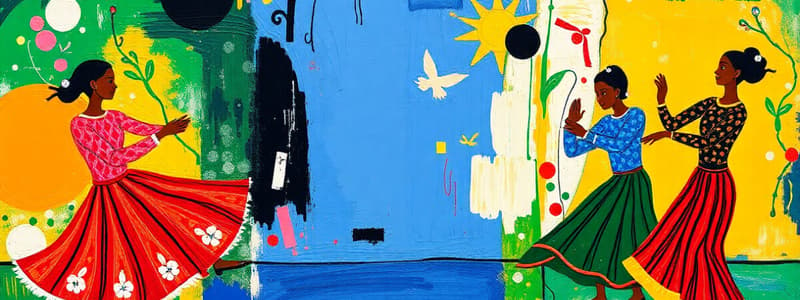Podcast
Questions and Answers
What is the primary focus of personal space?
What is the primary focus of personal space?
- Space available to a person in motion
- Area including multiple people moving
- Maximum reach of an individual
- Maximum space available to a person in a stationary position (correct)
General space includes areas where individuals are stationary.
General space includes areas where individuals are stationary.
False (B)
What are the three steps in making choreography?
What are the three steps in making choreography?
Analyze the music, create the steps or movements, apply it and analyze the space provided.
Philippine folk dances often begin and end with a ______.
Philippine folk dances often begin and end with a ______.
Which of the following is NOT a classification of Philippine folk dance?
Which of the following is NOT a classification of Philippine folk dance?
Match the following types of dances with their descriptions:
Match the following types of dances with their descriptions:
Folk dancing belongs to and emanates from the elite class of society.
Folk dancing belongs to and emanates from the elite class of society.
The primary accent in a mambo rhythm is on the ______ count of the measure.
The primary accent in a mambo rhythm is on the ______ count of the measure.
Which of the following best describes general space?
Which of the following best describes general space?
Personal space is defined as the maximum space a person can occupy while moving.
Personal space is defined as the maximum space a person can occupy while moving.
What is the term used for the design of movements in choreography?
What is the term used for the design of movements in choreography?
The four elements of space include direction, level, range, and ______.
The four elements of space include direction, level, range, and ______.
Match the following elements of space with their descriptions:
Match the following elements of space with their descriptions:
Study Notes
Space Classification
- Personal Space: The maximum area available to a person in a stationary position.
- General Space: Includes areas where one or more people move, such as gymnasiums, swimming pools, classrooms, ballrooms, plazas.
Elements of Space
- Direction: Movement directions include forward, backward, upward, downward, sideways, right, left, diagonal, and combinations.
- Level: Refers to height, categorized as high, medium, middle, and low.
- Range: The maximum reach of an individual, often considered personal space.
- Pathways/Space Design: The line or design created in a space as someone moves.
- Focus: The direction a person's attention is directed.
Choreography
- The design of movement sequences.
- Also known as “Dance Writing.”
- Three Steps:
- Analyze the music.
- Create steps or movements.
- Apply and analyze the space provided.
Philippine Folk Dance History and Background
- Art & Religion: Primitive civilizations held art and religion as serious concerns.
- They believed supernatural beings governed their fate.
- Hunting and fishing were crucial to their lifestyle.
- The interweaving of rhythm led to dance development, becoming a high-quality art form.
- Folk Dance: A cultural art form passed down through generations.
- It reflects the customs, beliefs, rituals, and occupations of a region or country.
- It originates from and belongs to the people.
Characteristics of Philippine Folk Dance
- Saludo: Most dances begin and end with a salute.
- Spacing: Dancers are usually far apart.
- Body Contact: Minimal to no physical contact between dancers.
- Pair Dancing: Many dances involve pairs.
- Long Formations: Often performed in long lines.
- Age & Gender: Performed by both young and old, and by both sexes.
Classification of Philippine Folk Dance
- Occupational Dances: Dances reflecting specific occupations.
- Religious or Ceremonial Dances: Dances performed for religious or ceremonial purposes.
- Comic Dances: Dances with humorous elements.
- Game Dances: Dances resembling games.
- Courtship Dances: Dances expressing romantic interest.
- Wedding Dances: Dances performed at weddings.
- Festival Dances: Dances celebrated during festivals.
La Cumbia, Mambo Samba
- La Cumbia: Popular dance rhythm originating from Colombia, also popular in Chile and Mexico.
- Often classified as salsa in 4/4 time signature.
- Mambo Samba: Mambo is written in "cut time" with a four-count rhythm.
- Primary accent on the second count, secondary accent on the fourth count.
- Syncopation creates a jerky staccato effect.
- Samba, originally in 2/4 time, is often played in "cut time" with a syncopated beat.
- Dancers perform three steps to two counts of music, often called "step-and-cut."
Space Classification
- Personal Space: The maximum area an individual can occupy while stationary.
- General Space: Includes areas where people move, like gyms, swimming pools, classrooms, ballrooms, plazas, etc.
Elements of Space
- Direction: Refers to the possible movement directions: forward, backward, upward, downward, sideways, right, left, diagonal, and combinations of these directions.
- Level: Describes the height of space: high, medium (middle), and low.
- Range: Represents the maximum reach of an individual, often referred to as personal space.
- Pathways or Space Design: The lines or patterns created within a space as one moves.
- Focus: The direction a person's attention is directed towards.
Choreography
- Refers to the design itself.
- Also called "Dance Writing".
- Three steps for creating choreography:
- Analyze the music.
- Create steps or movements.
- Apply and analyze the available space.
Studying That Suits You
Use AI to generate personalized quizzes and flashcards to suit your learning preferences.
Description
Explore the intricate relationship between space classification and choreography in Philippine folk dance. This quiz delves into personal and general space, movement directions, levels, and the essential elements of dance writing. Test your knowledge on how these concepts shape the art of dance.



